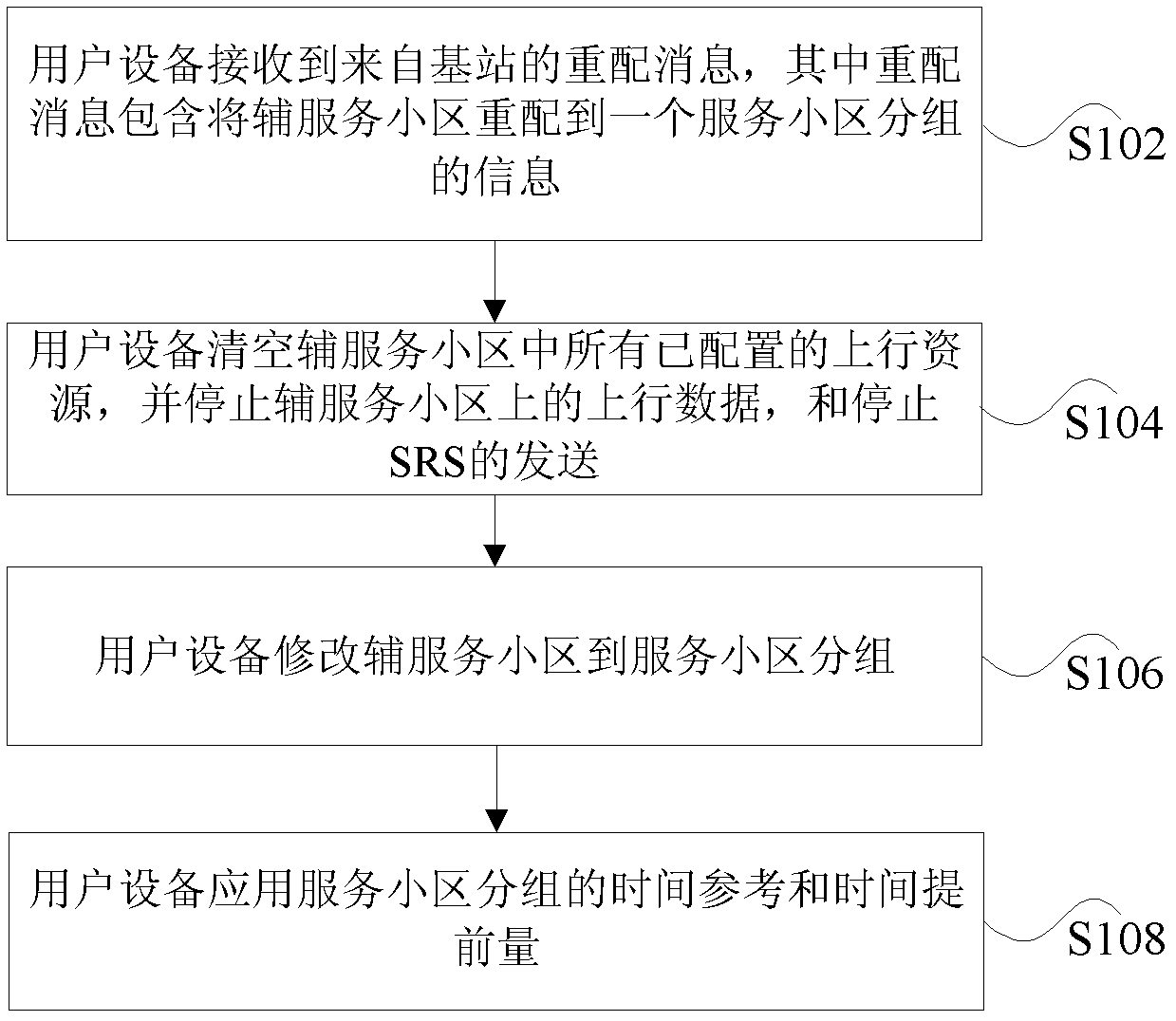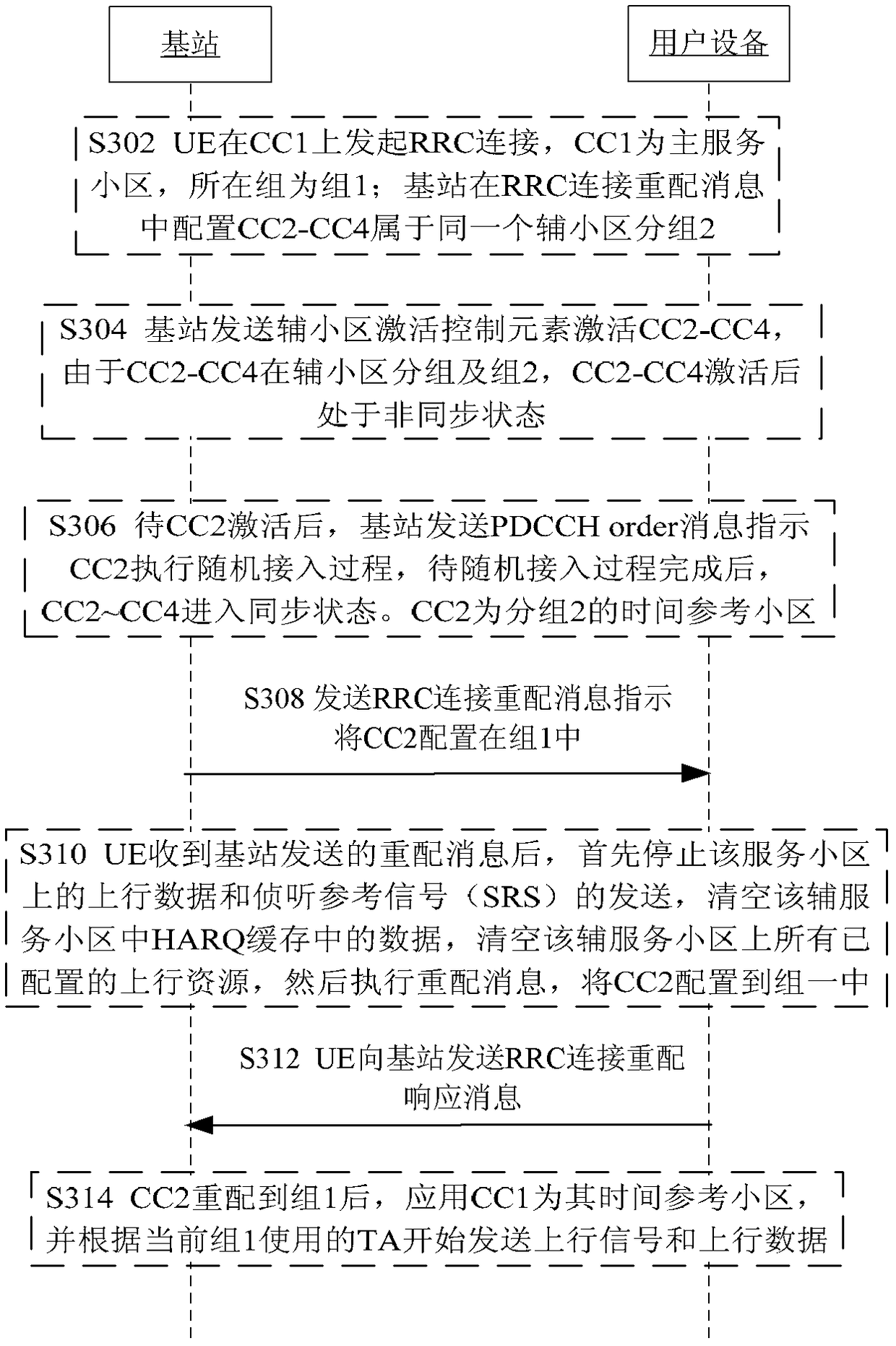Reconfiguration method and device for auxiliary serving cell in multi-carrier communication system
A secondary serving cell and multi-carrier communication technology, applied in the communication field, can solve problems such as uplink interference and achieve the effect of avoiding uplink interference
- Summary
- Abstract
- Description
- Claims
- Application Information
AI Technical Summary
Problems solved by technology
Method used
Image
Examples
Embodiment 1
[0050] image 3 It is an interactive flow chart of the reconfiguration method of the secondary serving cell in the multi-carrier communication system according to the preferred embodiment 1 of the present invention, as shown in image 3 As shown, the following steps S302 to S314 are included.
[0051] In step S302, the UE initiates an RRC connection on CC1, and the base station configures CC2, CC3, and CC4 information and grouping information to the UE in an RRC connection reconfiguration message. CC1 is the primary serving cell, forming group 1, and CC2-CC4 are secondary serving cells, forming group 2.
[0052] In step S304, the base station sends a secondary cell activation control element to activate CC2-CC4 when the UE is in the RRC connection state. Since CC2-CC4 belong to group 2, CC2-CC4 are in an asynchronous state after activation.
[0053] Step S306, after CC2 is activated, the base station sends a PDCCH order message to instruct CC2 to perform a random access proc...
Embodiment 2
[0059] Figure 4 It is an interactive flow chart of the reconfiguration method of the secondary serving cell in the multi-carrier communication system according to the second preferred embodiment of the present invention, as shown in Figure 4 As shown, the following steps S402 to S418 are included.
[0060] In step S402, the UE initiates an RRC connection on CC1, and the base station configures CC2, CC3, and CC4 information and grouping information to the UE in an RRC connection reconfiguration message. CC1 is the primary serving cell, forming group 1, and CC2-CC4 are secondary serving cells, forming group 2.
[0061] In step S404, the base station sends a secondary cell activation control element to activate CC2-CC4 when the UE is in the RRC connection state. Since CC2-CC4 belong to group 2, CC2-CC4 are in a synchronous state after activation.
[0062] Step S406, after CC2 is activated, the base station sends a PDCCH order message to instruct CC2 to perform a random access...
Embodiment 3
[0070] Figure 5 It is an interactive flow chart of the reconfiguration method of the secondary serving cell in the multi-carrier communication system according to the third preferred embodiment of the present invention, as shown in Figure 5 As shown, the following steps S502 to S514 are included.
[0071] In step S502, the UE initiates an RRC connection on CC1, and the base station configures CC2, CC3, and CC4 information and grouping information to the UE in an RRC connection reconfiguration message. CC1 is the primary serving cell, CC2 and CC1 are grouped in the same serving cell to form group 1, and CC3 and CC4 are secondary serving cells to form group 2.
[0072] Step S504, the base station sends a secondary cell activation control element to activate CC2~CC4 when the UE is in the RRC connection state, CC2 and CC1 are in the same group, and after CC2 is activated, they are in a synchronized state; CC3 and CC4 are in group 2, and after activation, they are in an uplink a...
PUM
 Login to View More
Login to View More Abstract
Description
Claims
Application Information
 Login to View More
Login to View More - R&D
- Intellectual Property
- Life Sciences
- Materials
- Tech Scout
- Unparalleled Data Quality
- Higher Quality Content
- 60% Fewer Hallucinations
Browse by: Latest US Patents, China's latest patents, Technical Efficacy Thesaurus, Application Domain, Technology Topic, Popular Technical Reports.
© 2025 PatSnap. All rights reserved.Legal|Privacy policy|Modern Slavery Act Transparency Statement|Sitemap|About US| Contact US: help@patsnap.com



